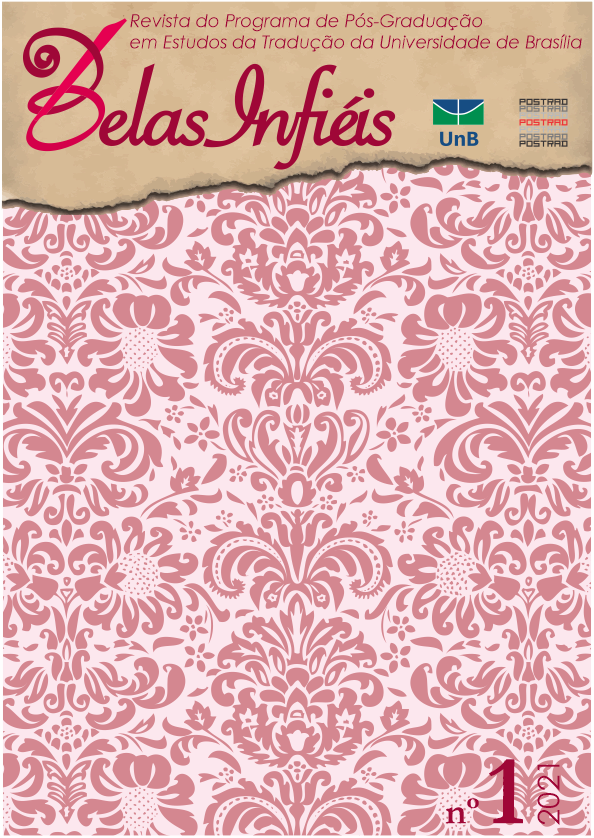Da dicotomia surdos versus ouvintes na tradução de contos clássicos a partir da cultura surda: um revide subversivo por meio da apropriação?
DOI:
https://doi.org/10.26512/belasinfieis.v10.n1.2021.32648Palavras-chave:
Tradução literária. Literatura Surda impressa. Identidades culturais. Literatura e tradução. Identidade Surda.Resumo
Durante a história da humanidade, por vezes, a surdez foi confundida com uma limitação, uma mazela ou até mesmo um castigo, delegando aos surdos condições periféricas e quase sempre condicionadas aos achismos do poderio hegemônico de cada dado contexto. Entretanto, na contemporaneidade é perceptível o despertar de uma consciência surda, uma busca por afirmação identitária, e a literatura traduzida, enquanto meio de expressão simbólica e produto de identidades capazes de construir significados socialmente reconhecíveis nos meios em que circula, atua como uma importante ferramenta de empoderamento sociopolítico e educacional dos surdos. Dessa forma, este artigo, enquanto recorte da pesquisa de mestrado intitulada A tradução de contos populares clássicos com escopos definidos: um passeio pelas versões impressas de Cinderela Surda (2003), Rapunzel Surda (2003) e Patinho Surdo (2005), desenvolvida junto ao Programa de Pós-Graduação em Letras na Universidade Estadual de Maringá (UEM), na área de concentração em Estudos Literários, visa refletir sobre a tradução dos contos populares clássicos a partir da cultura surda em Cinderela Surda (HESSEL; KARNOPP; ROSA, 2003), Rapunzel Surda (KARNOPP; ROSA; SILVEIRA, 2003) e Patinho Surdo (KARNOPP; ROSA, 2005). Tendo como referência os estudos de Venuti (2002), busco nessa análise investigar a representação das identidades culturais que se constroem neste processo tradutório.
Downloads
Referências
Afanas’ev, A. (2003). Contos de fadas russos. (D. A. Azevedo, Trans.). São Paulo: Landy Editora.
Alves, E. R. F. (2006). Outremização e revide de colonizado e colonizador em The Narrative of Jacobus Coetzee (1974), de J. M. Coetzee. 2006. 192 f. [Dissertação de Mestrado – Universidade Estadual de Maringá, Maringá].
Andersen, H. C. (2010). The ugly duck and other tales. Withefish: Kessinger.
Asbjørsen, P. C., Moe, J. (1859). Popular Tales from the Norse, (2. ed., pp. 411-428). (G. W. Dasent, Trans.). Edinburgh: Edmonston and Douglas.
Asbjørsen, P. C., MOE, J. (2013). Por que o mar é salgado: contos populares da Noruega. (K. L. Garrubo, Trans.). São Paulo: Berlendis.
Ashcroft, B., Griffiths, G., Tiffin, H. (1991). The empire writes back. New York: Routledge.
Bettelheim, B. (1980). A psicanálise dos contos de fadas. (A. Caetano, Trans.). Rio de Janeiro: Paz e Terra.
Bonnici, T. (2000). O pós-colonialismo e a literatura: estratégias de leitura. Maringá: EDUEM.
Grimm, W., Grimm, J. (1991). Contos de Grimm. (M. H. Penteado, Trans.). (2. ed., Vol. 2). São Paulo: Ática, 1991.
Grimm, W., Grimm, J. (2012). Grimm’s complete fairy tales. New York: Barnes&Noble.
Hermans, T. (1996). Translation’s other. London: University College.
Hessel, C., Karnopp, L. B., Rosa, F. (2003). Cinderela Surda. Canoas: ULBRA.
Karnopp, L. B., Rosa, F. (2005). Patinho Surdo. Canoas: Ed. ULBRA.
Karnopp, L. B., Rosa, F., Silveira, C. H. (2003). Rapunzel Surda. Canoas: ULBRA.
La Force, C. R. C. (2014) Persinette, the maiden in the tower. (R. L. Lawrence, Trans.). (Kindle Edition). Blackdown Publications.
Perrault, C. (1989). Contos de Perrault. (R. R. Junqueira, Trans.). (2. ed.). Belo Horizonte: Itatiaia.
Pratt, M. L. (1999). Os olhos do império. Bauru: USC.
Sousa, D. V. C. Língua Brasileira de Sinais e Língua de Sinais Francesa: uma relação histórica, linguística e cultural. http://www.brasilazur.com/2012/09/linguabrasileira-de-sinais-e-lingua-de-sinais-francesa-uma-relacao-historica-linguistica-e-cultural/. Recuperado em julho de 2020.
Spivak, G. C. (1985). The rani of sirmur: an essay in reading the archives. History and Theory, 24(3), 247-272.
Spivak, G. C. (1995). Can the subaltern speak? In B. Ashcroft, G. Griffiths & H. Tiffin. The post-colonial studies reader (pp. 24-28). London: Routledge.
Tatar, M. (Org.). Contos de fadas: edição comentada e ilustrada. (M. L. X. A. Borges, Trans.). Rio de Janeiro: Jorge Zahar Ed.
Venuti, L. (2002). Escândalos da Tradução. (L. Pelegrini et al. Trans.). Bauru: EDUSC.
Downloads
Publicado
Como Citar
Edição
Seção
Licença
Copyright (c) 2021 CC BY

Este trabalho está licenciado sob uma licença Creative Commons Attribution 4.0 International License.
Dado ao acesso público desta revista, os textos são de uso gratuito, com obrigatoriedade de reconhecimento da autoria original e da publicação inicial nesta revista
A revista permitirá o uso dos trabalhos publicados para fins não comerciais, incluindo direito de enviar o trabalho para bases de dados de acesso público. As contribuições publicadas são de total e exclusiva responsabilidade dos autores.
Os autores, ao submeterem trabalhos para serem avaliados pela revista Belas Infiéis, mantêm os direitos autorais e concedem à revista o direito de primeira publicação, sendo o trabalho licenciado sob a Creative Commons Attribution License Atribuição 4.0 Internacional (CC BY 4.0).



















